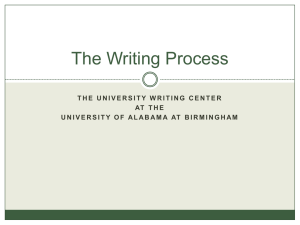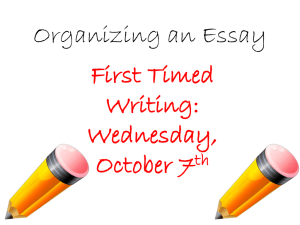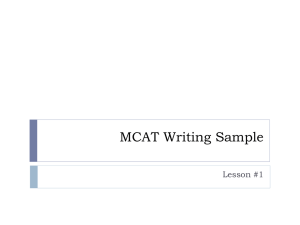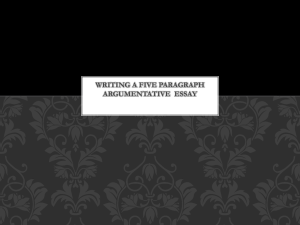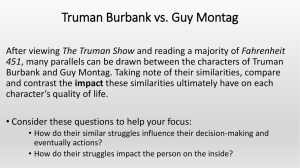Workshop | Spontaneous Writing Sample for TEP
advertisement
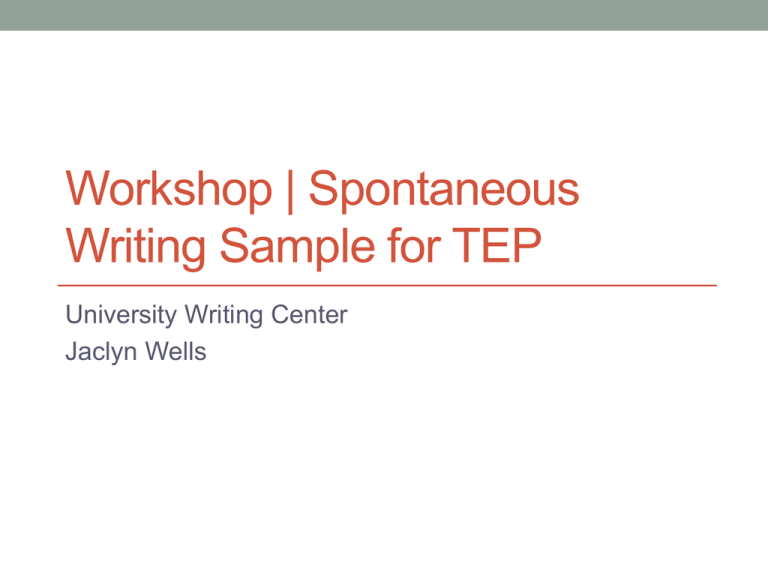
Workshop | Spontaneous Writing Sample for TEP University Writing Center Jaclyn Wells Today’s agenda Today’s goal is to provide general ideas and practice for tackling the Spontaneous Writing Sample for TEP Admissions. As we will discuss, this is a unique writing situation that demands specific skills and processes. Today, we will: • Discuss the assignment and rubric • Consider the challenges of this writing situation • Talk about strategies for the timed writing process • Practice elements of the writing process: pre-writing, editing • Critique thesis statements, reasons, examples, and details • Look at resources for additional help What are you doing? Let’s begin this workshop at the beginning by looking at the directions for the Spontaneous Writing Sample. What’s important in these directions? • You are making an argument. • You are supporting the argument with specific reasons, examples, • • • • and details. You are drawing those reasons, examples, and details from your own experience, observations, and readings. You only have 45 minutes for the whole process: prewriting/planning, drafting, and editing. You will have a dictionary, but no spell check, autocorrect, etc. Your writing will be evaluated with a specific rubric. How are you being evaluated? At this point, you have probably all seen the rubric for the Spontaneous Writing Sample. Have you studied it closely? Let’s look at this rubric and discuss the dimensions. What do these dimensions mean? 1. 2. 3. 4. 5. 6. Thesis Organization Key ideas and details Sentence variety Use of language Grammar, usage, mechanics What are the challenges? You have probably been writing in a variety of situations for a long time: papers in high school, more papers in college writing classes, and essays exams in high school and college. So, what is difficult about this particular situation? • You are making an argument. Not just exploring your ideas, reflecting on your experience, or summarizing something you’ve read. Those might form a part of what you do, but stating and supporting a specific position is fundamental. • You have limited resources: You will not have the internet to find support for your arguments, and you will not have spellcheck to proofread. You are on your own. • You have to condense your entire writing process—pre-writing, writing, and editing—down to 45 minutes. • The positions are complex. The writing process Everyone follows a different writing process. If your process looks different from someone else’s, that does not necessarily mean you are doing it wrong. That said, most successful writers follow some version of the following steps: • Pre-writing (planning), which can include brainstorming ideas, mapping (especially if you’re a visual learner), and outlining. • Drafting. This is the actual writing part. • Revising for “higher-order concerns,” so things like thesis, organization, development of ideas, etc. • Editing for “lower-order concerns,” so things like spelling, grammar, mechanics, and sentence variety. The timed writing process What’s difficult about timed writing is that you have to condense these steps down into 45 minutes. Even when what you’re writing is short, that’s quite intimidating, especially when the stakes are high. Many writers are tempted to save time by skipping steps. DON’T! Most important advice…ever The number one mistake people make in timed writing situations is skipping important parts of the writing process, particularly pre-writing/planning and editing. If you take nothing else away from today, remember: Even though you only have 45 minutes, it is crucial to slow down and include pre-writing and editing in your process. You need time to plan your essay by brainstorming ideas, crafting a thesis, and creating an outline. You need time to edit your essay so you don’t make silly mistakes like spelling or grammar errors. Why pre-write? The problems with skipping pre-writing are many: • When you jump right into drafting, your first paragraph or two are pre-writing. You’re not making an argument for an audience; instead, you’re thinking out your ideas in writing. You do not want your reader to see this messy process. • Your thesis and organization go out the window because you have not allowed yourself time to plan before you begin writing. • You leave out key ideas and details that you might have thought if you’d allowed yourself time to think. Maybe you will think of those ideas as you write, but by that point, they end up all over the place because you haven’t planned where in the essay to put them. • You sometimes end up writing too much. Your goal here is to write an effective essay, not just a long one. Quality, not quantity. Why revise? When you revise, you focus on higher-order concerns like thesis, organization, transitions, and development of ideas. It is true that you will not have enough time to make major revisions to your essay after drafting. In a timed writing situation, this is simply unrealistic. However, you can: • Check that your thesis statement is clear, strong, and reflective of the rest of your essay. And if it’s not, you can revise the statement. • Look at the transitions between your body paragraphs and add in better transition words and phrases to improve the flow. • Consider your key ideas and details. While you will not have time to re-write them, you might have time to insert an extra example here and there and erase details that you realize are irrelevant. Why edit? When you skip editing or neglect to leave adequate editing time, you make mistakes that you should catch. A couple points you may not realize: • We are not able to edit quickly. When you “edit” by skimming your essay, your brain will correct mistakes automatically instead of register that the mistakes are there. Reading slowly and carefully— as if you’re reading aloud—will help you catch homonym errors, missing words, missing punctuation, run-on sentences, etc. • We have grown so accustomed to autocorrect, spellcheck, and texting language that we are perhaps even more prone to making silly errors while drafting. Checking for these is very important. • Editing well is possible in this test, since you will write in pencil (bring an eraser!) and will have access to a dictionary. How do I get it all done? No one can tell you what process to follow. The process below is only a suggestion—you might practice a couple of times and tweak the process as needed. 1. Pre-writing/planning: 5-10 minutes • • • • 2. Read the possible topics and choose one Determine your position and draft a thesis that states it Jot down ideas to support your position (remember: reasons, examples, details) Map an outline (consider the 5-paragraph model) Writing/drafting: 30-35 minutes • Refer always to your pre-writing/planning notes • Keep an eye on the clock so you can leave time to edit • Remember: quality, not quantity 3. Revising/editing: 5-10 minutes • • • • Read through the whole essay slowly, as though you’re reading aloud Pay special attention to beginnings and endings: of paragraphs, of the essay Double-check your thesis, topic sentences, and transitions Look for errors you know you make commonly, such as homonyms or run-ons Pre-writing practice Let’s practice the all important step of pre-writing/planning your essay. Take out a sheet of paper. With the example topic below, take ten minutes to: • Determine your position. Remember, you are discussing the extent to which you agree or disagree with the opinion stated. • Draft a thesis that clearly states your position • Jot down ideas to support your position. Remember, you need reasons, examples, and details. • Map an outline. Consider using the 5-paragraph model: introduction with thesis, three body paragraphs, conclusion. Example topic: “High school education should aim to prepare all students to attend college.” Editing in timed writing The best way to prepare for editing in a timed writing situation is to become familiar with your own common patterns of error. Writers tend to make the same errors (and not make others) repeatedly—we all have our unique error patterns. Knowing your patterns will make proofreading easier. Below are some particularly common errors. Even experienced writers make them occasionally, especially in a timed writing situation, so you might pay special attention when editing: • Spelling, particularly homonyms like meet/meat or there/their • Left out or doubled words • Missing or unnecessary apostrophes • Apostrophes indicate possession and contractions • Apostrophes not necessary to make words plural More common errors Other common errors include: • • • • • • • Fragment sentences Run-ons and comma splices Subject-verb agreement Verb tense consistency Parallel structure Pronoun usage Dangling modifiers We do not have time to look at each of these common errors, but you can follow the links to the Purdue Online Writing Lab for more information. A University Writing Center tutor can also work with you on any of these errors or help you generally with your editing process. Final suggestions As you prepare for the Spontaneous Writing Sample, keep these suggestions in mind: • Timed writing is a unique situation that requires special skills. Even • • • • if you are a fantastic writer, you have to practice timed writing to do it well and develop an effective process. The more you practice, the better you will do. And don’t forget to time yourself as you practice! Always remember: You are writing an argument, and you are supporting it with reasons, examples, and details. The 5-paragraph model (intro, 3 body paragraphs, conclusion) does not work for all writing situations, but it can provide a useful blueprint for timed writing like this. Go in knowing your weaknesses, particularly with sentence-level errors. If you know that you really struggle with run-on sentences, you can save time by looking for them specifically as you edit. Strive to produce quality, not quantity. Additional Resources • The University Writing Center offers free one-on-one consultations for all writers at UAB. Our tutors can help at any stage of the writing process and with any type of writing issue. You might meet with a tutor to get feedback on practice samples, discuss your common issues, or practice timed writing strategies. Make an appointment online at our website: www.uab.edu/writingcenter. • The UWC’s Ask-a-Tutor service can help with short writing questions. Simply email askatutor@uab.edu with your question and receive a response within 48 hours. • The Purdue Online Writing Lab contains many resources on the writing process and common writing errors. Visit the OWL: http://owl.english.purdue.edu/

